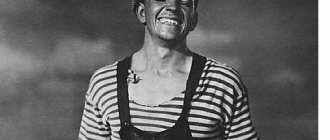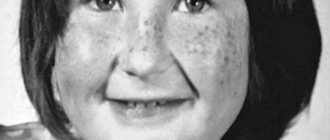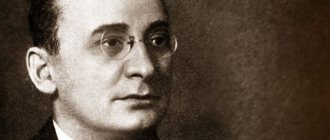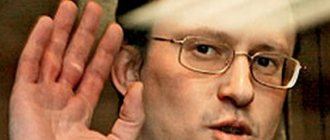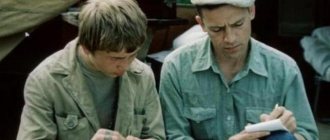This term has other meanings, see Dante (meanings).
| Dante Alighieri | |
| Italian Dante Alighieri | |
| Portrait by Sandro Botticelli (1495) | |
| Birth name | Italian Durante di Alighiero degli Alighieri |
| Date of Birth | no earlier than May 21, 1265 and no later than June 1, 1265 |
| Place of Birth |
|
| Date of death | 14 September 1321[1][2](age 56) |
| A place of death |
|
| Citizenship (nationality) |
|
| Occupation | prose writer, poet |
| Years of creativity | 1292—1321 |
| Language of works | Old Italian, Latin |
| Works on Wikisource | |
| Files on Wikimedia Commons | |
| Quotes on Wikiquote | |
Dante Alighieri
(Italian: Dante Alighieri, full name
Durante degli Alighieri,
last ten days of May [⇨] 1265 - on the night of September 14, 1321) - Italian poet, thinker, theologian, one of the founders of the literary Italian language, political figure. The creator of the “Comedy” (later receiving the epithet “Divine”, introduced by Boccaccio), which provided a synthesis of late medieval culture[3].
Content
- 1 Biography 1.1 In Florence
- 1.2 Years of exile
- 1.3 Death
- 1.4 Brief chronology of life and creativity
- 3.1 "New Life"
- 4.1 Writings
Biography
In Florence
According to family tradition, Dante's ancestors came from the Roman family of Elisei, who participated in the founding of Florence. Cacciaguida, Dante's great-great-grandfather, participated in the crusade of Conrad III (1147-1149), was knighted by him and died in battle with the Muslims. Cacciaguida was married to a lady from the Lombard family of Aldighieri da Fontana. The name "Aldighieri" was transformed into "Alighieri"; This is how one of the sons of Kachchagvida was named. The son of this Alighieri, Bellincione, Dante's grandfather, expelled from Florence during the struggle between the Guelphs and Ghibellines, returned to his hometown in 1266, after the defeat of Manfred of Sicily at Benevento. Alighieri II, Dante's father, apparently did not take part in the political struggle and remained in Florence.
Dante in the fresco of the Villa Carduccio by Andrea del Castagno (1450, Uffizi Gallery)
Dante's exact date of birth is unknown. According to Boccaccio [comm. 1], Dante was born in May 1265. Dante himself reported about himself (Comedy, Paradise, 22) that he was born under the sign of Gemini, which begins on May 21. Modern sources most often give dates for the second half of May [comm. 2]1265 years. It is also known that Dante was baptized on March 25[4] 1266 (on the first Holy Saturday) under the name Durante.
Dante's first mentor was the then famous poet and scientist Brunetto Latini. The place where Dante studied is unknown, but he gained extensive knowledge of ancient and medieval literature, the natural sciences, and was familiar with the heretical teachings of that time.
It is assumed with a fairly high degree of certainty that in 1286-1287 Dante lived for several months in Bologna near the towers of Garisenda and Asinelli that have survived to this day. In the absence of any documentary evidence, researchers admit that the most likely reason for his stay in this city could be his studies at the famous university[5].
Dante's closest friend was the poet Guido Cavalcanti. Dante dedicated many poems and fragments of the poem “New Life” to him.
The first official mention of Dante Alighieri as a public figure dates back to 1296 and 1297; already in 1300 or 1301 he was elected prior. In 1302, Dante was expelled from Florence along with his party of white Guelphs[6]. He never saw his hometown again and died in exile.
Years of exile
Monument to Dante 1865 Florence.
The work of the sculptor E. Pazzi The years of exile were years of wandering for Dante. Already at that time he was a lyric poet among the Tuscan poets of the “new style” - Cino from Pistoia, Guido Cavalcanti and others. His “La Vita Nuova (New Life)” had already been written; his exile made him more serious and strict. He starts his “Feast” (“Convivio”), an allegorical scholastic commentary on the fourteen canzones. But “Convivio” was never finished: only the introduction and interpretation to the three canzones were written. The Latin treatise on the popular language, or eloquence (“De vulgari eloquentia”), is also unfinished, ending at the 14th chapter of the second book.
During the years of exile, three cants of the Divine Comedy were created gradually and under the same working conditions. The time at which each of them was written can only be approximately determined. Paradise was completed in Ravenna, and there is nothing incredible in Boccaccio’s story that after the death of Dante Alighieri, his sons for a long time could not find the last thirteen songs, until, according to legend, Dante dreamed of his son Jacopo and told him where they lay.
There is very little factual information about the fate of Dante Alighieri; his trace has been lost over the years. At first, he found shelter with the ruler of Verona, Bartolomeo della Scala; The defeat in 1304 of his party, which tried by force to achieve installation in Florence, doomed him to a long wandering around Italy. He later arrived in Bologna, in Lunigiana and Casentino, in 1308–1309. ended up in Paris, where he spoke with honor at public debates, common in universities of that time. It was in Paris that Dante received the news that Emperor Henry VII was going to Italy. The ideal dreams of his “Monarchy” were resurrected in him with renewed vigor; he returned to Italy (probably in 1310 or early 1311), seeking renewal for her and the return of civil rights for himself. His “message to the peoples and rulers of Italy” is full of these hopes and enthusiastic confidence, however, the idealistic emperor died suddenly (1313), and on November 6, 1315, Ranieri di Zaccaria of Orvietto, King Robert’s viceroy in Florence, confirmed the decree of exile regarding Dante Alighieri, his sons and many others, condemning them to execution if they fell into the hands of the Florentines.
Dante's tombstone in Ravenna
From 1316-1317 he settled in Ravenna, where he was summoned to retire by the lord of the city, Guido da Polenta. Here, in the circle of children, among friends and fans, the songs of Paradise were created.
Death
In the summer of 1321, Dante, as the ambassador of the ruler of Ravenna, went to Venice to conclude peace with the Republic of St. Mark. On the way back, Dante fell ill with malaria and died in Ravenna on the night of September 14, 1321.
Dante was buried in Ravenna; the magnificent mausoleum that Guido da Polenta prepared for him was not erected. The modern tomb (also called the “mausoleum”) was built in 1780. The familiar portrait of Dante Alighieri lacks authenticity: Boccaccio depicts him with a beard instead of the legendary clean-shaven one, however, in general, his image corresponds to our traditional idea: an elongated face with an aquiline nose, large eyes , wide cheekbones and a prominent lower lip; always sad and thoughtfully focused.
| External images | |
| Dante | |
| (Death mask) | |
Brief chronology of life and creativity
- 1265 - birth.
- 1274 - first meeting with Beatrice.
- 1283 - second meeting with Beatrice.
- 1290 - death of Beatrice.
- 1292 - creation of the story “New Life” (“La Vita Nuova”).
- 1296/ - the first mention of Dante as a public figure.
- 1298 - marriage to Gemma Donati.
- 1300/ - Prior of Florence.
- 1302 - expelled from Florence.
- 1304-1307 - Treatise "Feast".
- 1304-1306 - treatise “On Popular Eloquence.”
- 1306-1321 - creation of the Divine Comedy.
- 1308/ - Paris.
- 1310/ - return to Italy.
- 1315 - confirmation of the expulsion of Dante and his sons from Florence.
- 1316-1317 - settled in Ravenna.
- 1321 - how the ambassador of Ravenna goes to Venice.
- On the night of September 13 to September 14, 1321, he dies on the way to Ravenna.
Death
In the summer of 1321, Dante, as the ambassador of the ruler of Ravenna, went to Venice to conclude peace with the Republic of St. Mark. On the way back, Dante fell ill with malaria and died in Ravenna on the night of September 13-14, 1321.
Dante was buried in Ravenna; the magnificent mausoleum that Guido da Polenta prepared for him was not erected. The modern tomb (also called the “mausoleum”) was built in 1780. The familiar portrait of Dante Alighieri lacks authenticity: Boccaccio depicts him with a beard instead of the legendary clean-shaven one, however, in general, his image corresponds to our traditional idea: an elongated face with an aquiline nose, large eyes , wide cheekbones and a prominent lower lip; always sad and thoughtfully focused.
Personal life
In the poem “New Life,” Dante glorified his first youthful love, Beatrice Portinari, who died in 1290 at the age of 24. Dante and Beatrice became a symbol of love, like Petrarch and Laura, Tristan and Isolde, Romeo and Juliet.
In 1274, nine-year-old Dante fell in love with a girl of eight years old, the daughter of a neighbor, Beatrice Portinari, at a May festival - this is his first biographical memory. He had seen her before, but the impression from this meeting was renewed in him when nine years later (in 1283) he saw her again as a married woman and this time became interested in her. Beatrice becomes the “mistress of his thoughts” for the rest of his life, a wonderful symbol of that morally uplifting feeling that he continued to cherish in her image, when Beatrice had already died (in 1290), and he himself entered into one of those business marriages, according to political calculation , which were accepted at that time.
The Dante family sided with the Florentine Cerchi party, which was at enmity with the Donati party. But Dante married Gemma Donati, daughter of Manetto Donati. The exact date of his marriage is unknown. It is known that in 1301 he already had three children (Pietro, Jacopo and Antonia)[7]. When Dante was expelled from Florence, Gemma remained in the city with the children, preserving the remnants of her father's property.
Later, when Dante composed his “Comedy” in glorification of Beatrice, Gemma was not mentioned in it even a single word. In recent years he lived in Ravenna; his sons, Jacopo and Pietro, poets, his future commentators, and his daughter Antonia gathered around him; only Gemma lived away from the whole family. Boccaccio, one of Dante's first biographers, summarized it all: that Dante married under duress and persuasion, and therefore during the long years of exile he never thought of calling his wife to him. Beatrice determined the tone of his feelings, the experience of exile - his social and political views and their archaism.
Brief chronology of life and creativity
1265 - Dante is born. 1274 - first meeting with Beatrice. 1283 - second meeting with Beatrice. 1290 - death of Beatrice. 1292 - creation of the story “New Life” (“La Vita Nuova”). 1296/97 - the first mention of Dante as a public figure. 1298 - Dante's marriage to Gemma Donati. 1300/01 - Prior of Florence. 1302 - expelled from Florence. 1304-1307 - “Feast”. 1304-1306 - treatise “On Popular Eloquence.” 1306-1321 - creation of the Divine Comedy. 1308/09 - Paris. 1310/11 - return to Italy. 1315 - confirmation of the expulsion of Dante and his sons from Florence. 1316-1317 - settled in Ravenna. 1321 - how the ambassador of Ravenna goes to Venice. On the night of September 13 to September 14, 1321, he dies on the way to Ravenna.
Creation
Dante Alighieri, a thinker and poet, constantly looking for a fundamental basis for everything that happened in himself and around him, it was this thoughtfulness, thirst for general principles, certainty, internal integrity, passion of the soul and boundless imagination that determined the qualities of his poetry, style, imagery and abstractness .
Love for Beatrice acquired a mysterious meaning for him; he filled every work with it. Her idealized image occupies a significant place in Dante's poetry. Dante's first works date back to the 1280s. In 1292, he wrote a story about his renewed love, “The New Life” (“La Vita Nuova”), composed of sonnets, canzones and a prose story-commentary about his love for Beatrice. “A New Life” is considered the first autobiography in the history of world literature. Already in exile, Dante writes the treatise “The Feast” (Il convivio, 1304-1307).
Alighieri also created political treatises. Later, Dante found himself in a whirlpool of parties, and was even an inveterate municipalist; but he had a need to understand for himself the basic principles of political activity, so he wrote his Latin treatise “On the Monarchy” (“De Monarchia”). This work is a kind of apotheosis of the humanist emperor, next to which he would like to place an equally ideal papacy. In his treatise “On Monarchy,” Dante the politician spoke. Dante the poet was reflected in the works “New Life”, “The Feast” and “The Divine Comedy”.
"New life"
Dante on the facade of the Uffizi Gallery
Main article: New Life (Dante)
In this first psychological novel in Europe, the feeling of love acquires an unprecedented height and spirituality. This is the first embodiment of that simple and at the same time unusually complex, fraught with many consequences, feeling that determined the development of the most cherished aspects of Dante’s soul. Dante's love is touching in its naivety and freshness, but at the same time one can feel in it the spirit of a stern and attentive spirit, the hand of an artist who thinks about many things at once, experiencing the most complex dramas of the heart. Imaginative descriptions of the virtues and virtues of Beatrice, a soulful analysis of Dante's ecstatic adoration of his beloved add brightness and spirituality to his schematic literary techniques.[8].
"Feast"
Main article: The Feast (Dante's treatise)
Romanian postage stamp dedicated to Dante Alighieri
In the Symposium (between 1304 and 1307) - and this is very characteristic of the historical originality of the Pre-Renaissance period, aesthetically realized in Dante's work - politics is organically combined not only with ethics, but also with poetics and linguistics[9].
Dante's Renaissance theories of style are preceded by the idea of the importance of spiritual support for “exemplary”, “correct poets”. Dante humanistically believed in the boundlessness of the creative powers of an individual creative personality, drawing inspiration from folk culture and close to the people's needs and worldview, embodying his true, “reasonable” aspirations in poetry, its style and language. The grammatically organized folk language of new literature and culture, which in the treatise “On Popular Eloquence” is proclaimed “primordial” and called “brilliant Italian folk speech,” was to be formed from the living colloquial speech of the regions of Italy under the influence of the cultural and literary activities of writers. The first treatise of the Symposium ends with the thought that this language will become “a new light, a new sun, which will rise where the familiar has set; and it gives light to those who are in darkness and darkness, since the old sun no longer shines for them” (I, XIII, 12)[9].
In The Feast there is a strong connection between new ideas and the search for a new style and language. When Dante creates a new Italian literary language and a “beautiful style,” he also takes care of their compliance with the requirements of the “noble lady,” which he calls (at the beginning of the third canzone) “Madonna philosophy.” In the canzone and in the accompanying discussions, Dante deepens and democratizes anti-class ideas about nobility as a kind of grace descending on a “well-disposed” soul; his concept of the “divinity” of man certainly acquires a humanistic essence. Dante’s nobility involves promoting the establishment of general prosperity and social harmony on earth in a worldwide and autocratic empire, for “to eliminate internecine wars and their causes, it is necessary that the whole earth and that everything that is given to the human race to own should be a Monarchy, that is, a single state , and had one sovereign, who, owning everything and not being able to desire more, would keep individual sovereigns within the boundaries of their possessions, so that peace would reign between them, which cities would enjoy, where neighbors would love each other, in this love everyone received a house according to his needs and so that, having satisfied them, each person lived happily, for he was born for happiness” (“Feast”, IV, IV, 4) [9].
The idea that happiness lies in man’s earthly existence, and “that the purpose of every virtue is to make our life more joyful” (ibid., I, VIII, 12) is undoubtedly revolutionary; one may recall that in the “Symposium” the idea of social world harmony - “every person is a friend to every other person by nature” (I, I, - is justified by the idea of the harmony of an individual, an ordinary earthly person. True, spiritual nobility in Dante presupposes bodily beauty, nobility of the flesh (IV, XXV, 12-13).These kinds of ideas anticipate the life-affirming worldview of the Italian Renaissance and also serve as prerequisites for the formation of the Renaissance style[9].
one may recall that in the “Symposium” the idea of social world harmony - “every person is a friend to every other person by nature” (I, I, - is justified by the idea of the harmony of an individual, an ordinary earthly person. True, spiritual nobility in Dante presupposes bodily beauty, nobility of the flesh (IV, XXV, 12-13).These kinds of ideas anticipate the life-affirming worldview of the Italian Renaissance and also serve as prerequisites for the formation of the Renaissance style[9].
"The Divine Comedy"
Analysis
Elizabeth Sonrel.
Scene from The Divine Comedy by Dante Alighieri In form, the Divine Comedy is an afterlife vision, a common genre in medieval literature. Like the poets of that era, the poem seems to be an allegorical building. Thus, the dense forest in which the poet got lost in the middle of his life’s journey is a symbol of the sins committed throughout his life and the delusions he experienced [comm. 3]. The three animals that attack him there: a lynx, a lion and a she-wolf are the three most powerful passions: voluptuousness, pride, greed, respectively [comm. 4]. These allegories are also given a political meaning: the lynx is Florence, the spots on its skin should indicate the enmity of the Guelph and Ghibelline parties; lion, symbol of brute physical strength - France; the she-wolf, greedy and lustful, is the papal curia. These beasts threaten the national unity of Italy, which Dante dreamed of, a unity cemented by the rule of the feudal monarchy [comm. 5] (some literary historians give Dante’s entire poem a political interpretation). Virgil saves the narrator from the beasts - reason[comm. 6], sent to the poet Beatrice (who appears here as a symbol of divine providence [comm. 7]). Virgil leads Dante through purgatory and on the threshold of heaven gives way to Beatrice. The essence of this allegory is this: reason saves a person from passions, and divine grace (Beatrice in translation from Italian - gracious) leads to eternal bliss.
“Comedy” is imbued with the author’s political predilections. Dante never misses an opportunity to reckon with his ideological opponents and personal enemies; he hates usurers, condemns credit as “usury”, his age as the age of profit and love of money. In his opinion, money is the source of many evils[10]. His dark present is contrasted with the bright past, bourgeois Florence - feudal Florence, when everyone valued moderation, simplicity of morals, knightly “courtesy” (“Paradise”, Cacciaguida’s story). The terzas of the "Purgatory" accompanying the appearance of Sordello (Purgatory, Canto VI) are a hymn of praise to Ghibellinism. Next, Dante praises Constantine and Justinian as the greatest emperors, placing them in paradise (Paradise, Canto VI); these most significant figures of the Roman Empire were supposed to serve as an example for the German emperors of that time, and in particular for Henry VII of Luxembourg, whom Dante called on to invade Italy and unite it on feudal principles. The poet treats the papacy as an institution with the highest respect, although he feels hatred towards its individual representatives, and especially those who contributed to the establishment of capitalism in Italy; some dads end up in hell. Dante's faith is Catholicism, although a personal element hostile to the old orthodoxy intrudes into it, although mysticism and the Franciscan pantheistic religion of love, accepted with all passion, also sharply deviate from Catholicism proper. His philosophy is theology, his science is scholasticism, his poetry is allegory. The ideals of asceticism in Dante are not yet dead, and therefore he considers free love to be a sin (Hell, Canto V, episode with Francesca da Rimini and Paolo). But it is not a sin for him to love, which attracts to the object of worship with a pure platonic impulse [comm. 8]. This is a great world force that “moves the sun and other luminaries.” And humility is no longer an unconditional virtue. “Whoever does not renew his strength in glory with victory will not taste the fruit he obtained in the struggle.” The spirit of inquisitiveness, the desire to expand one’s horizons, to discover new things, combined with “virtue”, encouraging heroic daring, is extolled as an ideal.
Dante created his vision from pieces of real life. The design of the underworld is made up of individual corners of Italy[11], placed in it with clear graphic contours. The poem depicts so many living human images, so many typical figures, so many vivid psychological situations, so many expressive and impressive scenes and episodes that art continues to draw from there in subsequent centuries, and even in our time[8]. Looking at the huge gallery of historical figures and persons depicted by Dante in the Comedy, you conclude that there is not a single image that would not be cut by the poet’s unmistakable plastic intuition. During Dante's era, Florence experienced an era of intense economic and cultural prosperity. That unusually acute sense of man and landscape in the Comedy, which the world learned from Dante, was possible only in the social situation of Florence in the 14th century, which then stood at the vanguard of European progress. Individual episodes, such as Francesca and Paolo, Farinata in his red-hot grave, Ugolino with his children, Capaneus and Ulysses, very unlike ancient images, the Black Cherub with subtle devilish logic, Sordello on his stone, still make a strong impression.[ 12].
Impact on culture
As indicated in the Newest Philosophical Dictionary, Dante’s poetry “played a large role in the formation of Renaissance humanism and in the development of the European cultural tradition as a whole, having a significant impact not only on the poetic-artistic, but also on the philosophical spheres of culture (from the lyrics of Petrarch and the Pleiades poets to sophiology of BC Solovyov)”[13].
Interesting facts from the life of Dante Alighieri
- Dante never mentions the name of his wife in any of his works, but he dedicated most of the sonnets and canzones from the collection La Vita Nuova (The New Life) to Beatrice, and she is one of the main characters in The Divine Comedy.
- Dante and Beatrice became a symbol of a love couple, such as Petrarch and Laura, Tristan and Isolde, Romeo and Juliet.
- Dante saw his beloved Beatrice only twice in his life - at the age of 9 and 18 .
- In 2008, the authorities of Florence, almost 690 years after the death of Dante Alighieri, reversed the decision to expel the poet from the city. However, this decision faced a lot of criticism and the public called it a commercial gimmick to attract tourists.
- His ancestors came from the Roman family of Eliseo , who took part in the founding of Florence. Dante's great-great-grandfather, Cacciaguida, even participated in Conrad III's crusade, was knighted and died in battle with the Muslims .
- When transporting Dante's ashes from Ravenna to his native Florence, the urn was stolen by Franciscan monks from a neighboring monastery , who did not want to part with the poet.
- worked on The Divine Comedy .
- Alighieri influenced such famous writers as William Shakespeare, Geoffrey Chaucer and John Milton .
- Thanks to The Divine Comedy, it is Dante's native Tuscan dialect that to this day serves as the basis of the literary Italian language .
- Each of the three parts of the Divine Comedy ends with the word "stars" .
- calls treason the most terrible sin , which would correspond to the 9th circle of hell . Even thieves and murderers are higher.
- The Divine Comedy is mentioned in many works, but one of the most popular is Dan Brown's 2013 novel Inferno . It was included on the Publishers Weekly bestseller list. The main role in the film adaptation of the novel was played by American actor Tom Hanks.
Tom Hanks and Rita WilsonDepositphotos
Let us remind you that 5.ua previously reported how a blind 10-year-old girl wrote her first book.
Bibliography
Essays
- 1292 "New Life" (Italian: Vita nuova)
- 1306-1321 “The Divine Comedy” - (Italian: Divina Commedia): Hell,
- Purgatory,
- Paradise
De vulgari eloquentia
, 1577
) in French. 13th-century allegorical novel
- Poems of the Florentine period:
Russian translations
"The Divine Comedy"
- A. S. Norov, “Excerpt from the 3rd song of the poem Hell” (“Son of the Fatherland”, 1823, No. 30);
- F. Fan-Dim, “Hell”, translation from Italian (St. Petersburg, 1842-48; prose);
- D. E. Min “Hell”, translation in the size of the original (Moscow, 1856);
- D. E. Min, “The First Song of Purgatory” (“Russian Vest.”, 1865, 9);
- V. A. Petrova, “The Divine Comedy” (translated with Italian terzas, St. Petersburg, 1871, 3rd edition 1872; translated only “Hell”);
- D. Minaev, “The Divine Comedy” (LPts. and St. Petersburg. 1874, 1875, 1876, 1879, translated not from the original, in terzas); reissue - M., 2006
- P. I. Weinberg, “Hell”, canto 3, “Vestn. Heb., 1875, No. 5);
- V. V. Chuiko, “The Divine Comedy”, prose translation, three parts published as separate books, St. Petersburg, 1894;
- M. A. Gorbov, Divine Comedy part two: With explanation. and note. M., 1898. (“Purgatory”);
- Golovanov N. N., “The Divine Comedy” (1899-1902);
- Chyumina O. N., “The Divine Comedy.” St. Petersburg, 1900, transl. not from the original (reprint - M., 2007). Half Pushkin Prize (1901)
- M. L. Lozinsky, “The Divine Comedy” (1946, Stalin Prize)[14];
- B.K. Zaitsev, “The Divine Comedy. Hell,” interlinear translation (prose, 1913–1918, first publication of individual songs in 1928 and 1931, first complete publication in 1961)[15];
- A. A. Ilyushin (created from the 1960s to 1980, first partial publication in 1988, full publication in 1995)[16];
- V. S. Lemport, “The Divine Comedy” (finished in 1997)[17];
- V. G. Marantsman, (St. Petersburg, 2006)
Russian translations
A. S. Norova, “Excerpt from the 3rd song of the poem Hell” (“Son of the Fatherland”, 1823, No. 30); his, “Predictions of D.” (from the XVII song of the poem Rai. “Literary sheets”, 1824, L” IV, 175); his, “Count Ugodin” (“News Liter.”, 1825, book XII, June). "Hell", trans. from Italian F. Fan-Dim (E. V. Kologrivova; St. Petersburg. 1842-48; prose). "Hell", trans. from Italian the size of the original by D. Mina (M., 1856). D. Min, “The First Song of Purgatory” (Russian Vest., 1865, 9). V. A. Petrova, “The Divine Comedy” (translated with Italian terzas, St. Petersburg, 1871, 3rd ed. 1872; translated only Hell). D. Minaev, “The Divine Comedy” (LPts. and St. Petersburg. 1874, 1875, 1876, 1879, translated not from the original, in terzas). "Hell", canto 3, trans. P. Weinberg (“Vestn. Evr.”, 1875, No. 5). “Paolo and Francesca” (Hell, wood. A. Orlov, “Vestn. Evr.” 1875, No. 8); “The Divine Comedy” (“Hell”, presentation by S. Zarudny, with explanations and additions, St. Petersburg, 1887). "Purgatory", trans. A. Solomon (“Russian Review”, 1892, in blank verse, but in the form of terza). Translation and retelling of Vita Nuova in the book by S., “Triumphs of a Woman” (St. Petersburg, 1892). Golovanov N. N. “The Divine Comedy” (1899-1902). M. L. Lozinsky “The Divine Comedy” (1946 Stalin Prize). Ilyushin, Alexander Anatolyevich. (“The Divine Comedy”) (1995). Lemport Vladimir Sergeevich “The Divine Comedy” (1996-1997).
Memory
Russian postal envelope, 2020
- In 1970, a crater on the far side of the Moon was named after Dante.
- In 2008, the computer game Dante's Inferno was released, which is a free interpretation of one of the parts of the Divine Comedy.
- In 2010, the animated cartoon Dante's Inferno: An Animated Epic was released[18].
- In 2020, the Bank of Russia issued coins (in regular and special versions) dedicated to the 750th anniversary of the birth of Dante Alighieri[19].
- In 2020, a postal envelope was issued in his honor in Russia.
Bank of Russia coins
"The Divine Comedy"
This work of Dante is considered a masterpiece not only of Italian, but also of world literature , as well as a real encyclopedia of the Middle Ages. In three parts ("Hell", "Purgatory", "Paradise") Dante described his journey to God . Dante's companion is the Roman poet Virgil; later Dante is accompanied by Beatrice, who personifies the mercy of God.
Dante decided to write The Divine Comedy for the sake of the spiritual salvation of man and the whole world . He wrote: “To save people from a shameful state and lead them to happiness.” He proclaimed the high ideals of Goodness, Love, Mercy, Reason, which, in his opinion, could change the life of society.
He completed part of “Paradise” in Ravenna during his exile. After the death of Dante Alighieri, his sons for a long time could not find the thirteen last songs, until, according to legend, Dante dreamed of his son Jacopo and told him where they lay .
In Ukraine, The Divine Comedy was mainly translated in parts, but subsequently several complete versions of the translation of all three parts were published. Among the translators were Ivan Franko, Father Pavel Shtokalo, Vladimir Samoilenko, Igor Kostetsky, Vasily Barka, Mikhail Drai-Khmara and others. A complete translation of all three parts was completed in 1976 by Evgeniy Drobyazko.
It is interesting that the Divine Comedy is called a “comedy” only because it is written in vulgar Italian , not noble Latin, but “divine” only because this epithet was later used in relation to it by Giovanni Boccaccio .
Dante AlighieriDepositphotos
Notes
Comments
- Golenishchev-Kutuzov I.N., 1968: Boccaccio received information from the notary Piero Giardini.
- The Philosophical Encyclopedic Dictionary (2010) gives the date May 30. The New Philosophical Encyclopedia (In 4 vols. M.: Mysl. Edited by V. S. Stepin. 2001) indicates the date of birth between May 18 and June 17. Robert Hollander, in the article "Dante" (Dictionary of the Middle Ages, 4 volume, 1984), writes that Dante Alighieri was born "probably at the end of May." I. N. Golenishchev-Kutuzov (Golenishchev-Kutuzov I. N., 1968) indicates the second half of May.
- See M. Lozinsky's commentary on line 13, Canto I, Hell
- See M. Lozinsky's commentary on lines 31-60, Canto I, Hell
- See Dante's treatise "On Monarchy"
- See M. Lozinsky's commentary on line 62, Canto I, Hell
- See M. Lozinsky's commentary on line 70, Canto II, Hell
- See "New Life" of Dante
Notes
- ↑ 1 2 3 German National Library, Berlin State Library, Bavarian State Library, etc.
Record #118523708 // General regulatory control (GND) - 2012-2016. https://wikidata.org/Track:Q27302″>https://wikidata.org/Track:Q304037″>https://wikidata.org/Track:Q256507″>https://wikidata.org/Track:Q170109 ″>https://wikidata.org/Track:Q36578″> - AA.V.V.
Dizionario Biografico degli Italiani - 1960.https://wikidata.org/Track:Q1128537″>https://wikidata.org/Track:Q2818964″>https://wikidata.org/Track:P1986″>
- A. Dzhivelegov.
DANTE ALIGHIERI. - Golenishchev-Kutuzov I. N., 1968.
- Marco Santagata, 2020, pp. 73-74.
- Malcolm Moore “Dante's infernal crimes forgiven”, Daily Telegraph
, June 17, 2008. Retrieved on June 18, 2008. - Siro A. Chimenz.
ALIGHIERI, Dante (Italian).
Dizionario Biografico degli Italiani - Volume 2
. Treccani (1960). Retrieved March 18, 2020. - ↑ 12Commentary by B. Krzhevsky on The Divine Comedy
- ↑ 1 2 3 4 Golenishchev-Kutuzov I.N., Khlodovsky R.I.
Dante Alighieri // Literature of Italy: Literature of the XIII-XIV centuries. / USSR Academy of Sciences; Institute of World Lit. them. A. M. Gorky. - M.: Nauka, 1985. - T. 3. - P. 57-58 from 51-68. - (History of world literature: in 9 volumes; 1983-1994). - I. N. Golenishchev-Kutuzov “Dante and world culture” / Dante in Russia, p. 490
- All the places in Italy in the Divine Comedy
- FEB: Dante Alighieri / Literary Encyclopedia, T. 3 - 1930
- The latest philosophical dictionary. — Minsk: Book House. A. A. Gritsanov. 1999.
- I. N. Golenishchev-Kutuzov “Dante and world culture”/Dante in Russia
- "Russian Hell of Boris Zaitsev"
- Dante size of the original
- New translation of Dante
- "Dante's Inferno: An Animated Epic" (English) on the Internet Movie Database
- Press release of the Bank of Russia dated June 29, 2015
Literature
- Barenboim P. D. “Constitutional ideas of Dante”, Legislation and Economics, No. 6, 2005, pp. 64-69
- Guenon R.
Esotericism of Dante // Philosophical Sciences. - 1991. - No. 8. - P. 132-170. - Golenishchev-Kutuzov I. N.
Dante. - Young Guard, 1967. - (Life of remarkable people). - Golenishchev-Kutuzov I. N.
The Life of Dante and His Small Works // Dante Alighieri. Small works. - M., 1968. - P. 419-447. - Golenishchev-Kutuzov I. N.
Dante in Russia; Dante in Soviet culture // Dante’s work and world culture. - M., 1971. - P. 454-486, 487 - 515. - Golenishchev-Kutuzov I. N.
Dante’s work and world culture / Edited and with an afterword by Academician V. M. Zhirmunsky. - Science, 1971. - Golenishchev-Kutuzov I. N., Khlodovsky R. I.
Dante Alighieri // Literature of Italy: Literature of the XIII-XIV centuries. / USSR Academy of Sciences; Institute of World Lit. them. A. M. Gorky. - M.: Nauka, 1985. - T. 3. - P. 51-68. - (History of world literature: in 9 volumes; 1983-1994). - Dante and world literature. M., 1967.
- Dzhivelegov A.K.
Dante, 1933. - 176 p. (Life of wonderful people) - Dobrokhotov A.L.
Dante Alighieri.- M.: Mysl, 1990.- 207, [1] p.-(Thinkers of the past) ISBN 5-244-00261-9 - Elina N. G.
Dante. M., 1965. - Zaitsev B.K.
Dante and his poem. M., 1922. - Rabinovich V.L.
“The Divine Comedy” and the myth of the philosopher’s stone // Dante’s readings. M., 1985. - Santagata M.
Dante. Il romanzo della sua vita. — Milano: Oscar Mondadori, 2015. — 467 p. — ISBN 978-88-04-63182-8.

